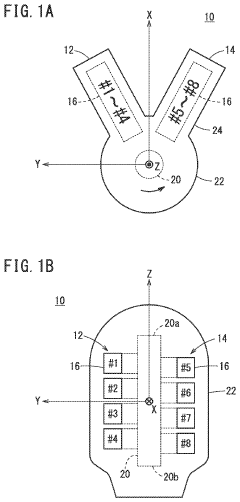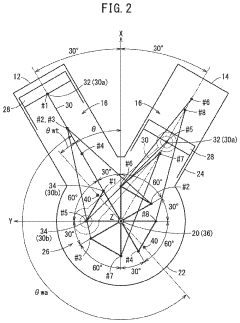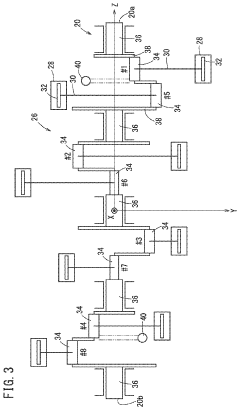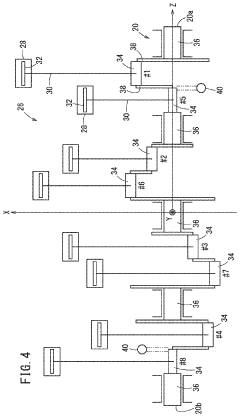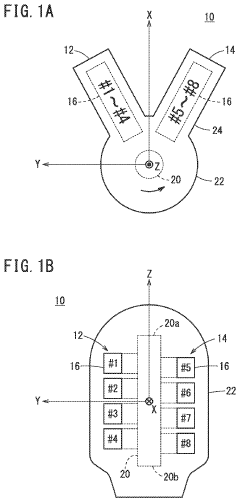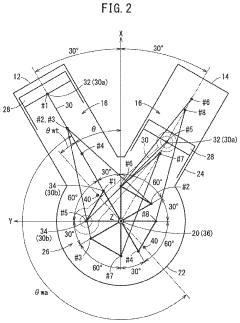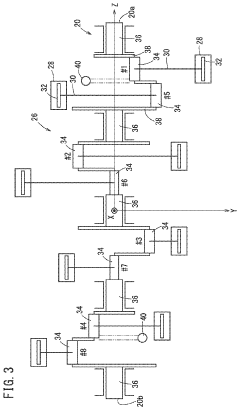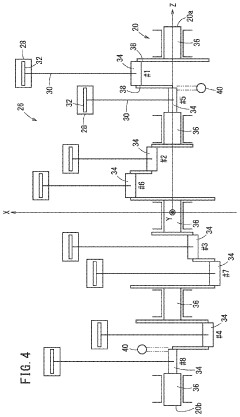V8 Engine Technical Overview: Innovations and Challenges
JUL 4, 20258 MIN READ
Generate Your Research Report Instantly with AI Agent
Patsnap Eureka helps you evaluate technical feasibility & market potential.
V8 Engine Background and Objectives
The V8 engine, developed by Google, has been a cornerstone of modern JavaScript execution since its introduction in 2008. Initially designed to enhance the performance of JavaScript in web browsers, V8 has evolved to become a crucial component in various runtime environments, including Node.js and Deno.
V8's development was driven by the need for faster JavaScript execution in web applications. As web technologies advanced, the demand for more complex and interactive web applications grew, necessitating a more efficient JavaScript engine. V8 addressed this need by introducing innovative compilation techniques, such as just-in-time (JIT) compilation and adaptive optimization.
Over the years, V8 has undergone significant improvements and iterations. Key milestones include the introduction of the Crankshaft compiler in 2010, which brought substantial performance gains through aggressive optimizations. In 2015, the TurboFan compiler was introduced, offering more flexible and maintainable optimization strategies.
The primary objective of V8 has been to maximize JavaScript execution speed while minimizing memory usage. This goal has led to continuous refinements in garbage collection algorithms, memory management techniques, and compilation strategies. V8's focus on performance has been instrumental in enabling the development of large-scale, complex web applications and server-side JavaScript environments.
Another critical objective of V8 has been to maintain compatibility with evolving ECMAScript standards while introducing new language features. This has allowed developers to leverage the latest JavaScript capabilities without sacrificing performance or compatibility across different platforms.
V8's influence extends beyond web browsers. Its adoption in Node.js has revolutionized server-side development, enabling JavaScript to be used across the full stack. This has led to increased developer productivity and the growth of a vast ecosystem of JavaScript libraries and frameworks.
Looking forward, V8 continues to evolve with the changing landscape of web and application development. Current objectives include further improving performance on mobile devices, optimizing for WebAssembly execution, and enhancing support for new JavaScript language features. The engine also aims to adapt to emerging computing paradigms, such as edge computing and serverless architectures, ensuring its relevance in future development scenarios.
V8's development was driven by the need for faster JavaScript execution in web applications. As web technologies advanced, the demand for more complex and interactive web applications grew, necessitating a more efficient JavaScript engine. V8 addressed this need by introducing innovative compilation techniques, such as just-in-time (JIT) compilation and adaptive optimization.
Over the years, V8 has undergone significant improvements and iterations. Key milestones include the introduction of the Crankshaft compiler in 2010, which brought substantial performance gains through aggressive optimizations. In 2015, the TurboFan compiler was introduced, offering more flexible and maintainable optimization strategies.
The primary objective of V8 has been to maximize JavaScript execution speed while minimizing memory usage. This goal has led to continuous refinements in garbage collection algorithms, memory management techniques, and compilation strategies. V8's focus on performance has been instrumental in enabling the development of large-scale, complex web applications and server-side JavaScript environments.
Another critical objective of V8 has been to maintain compatibility with evolving ECMAScript standards while introducing new language features. This has allowed developers to leverage the latest JavaScript capabilities without sacrificing performance or compatibility across different platforms.
V8's influence extends beyond web browsers. Its adoption in Node.js has revolutionized server-side development, enabling JavaScript to be used across the full stack. This has led to increased developer productivity and the growth of a vast ecosystem of JavaScript libraries and frameworks.
Looking forward, V8 continues to evolve with the changing landscape of web and application development. Current objectives include further improving performance on mobile devices, optimizing for WebAssembly execution, and enhancing support for new JavaScript language features. The engine also aims to adapt to emerging computing paradigms, such as edge computing and serverless architectures, ensuring its relevance in future development scenarios.
Market Demand for High-Performance JavaScript Engines
The demand for high-performance JavaScript engines has grown exponentially in recent years, driven by the increasing complexity and sophistication of web applications. As JavaScript continues to expand beyond its traditional role in front-end development to encompass server-side programming, desktop applications, and even mobile app development, the need for efficient execution of JavaScript code has become paramount.
Web browsers, being the primary platform for JavaScript execution, have been at the forefront of this demand. Users expect web applications to load quickly and run smoothly, regardless of the device or network conditions. This has put significant pressure on browser vendors to continually improve their JavaScript engines, with V8 being a key player in this competitive landscape.
The rise of Single Page Applications (SPAs) and Progressive Web Apps (PWAs) has further intensified the need for high-performance JavaScript engines. These modern web application architectures rely heavily on client-side JavaScript to handle complex logic, state management, and dynamic content rendering. As a result, the efficiency of JavaScript execution directly impacts the user experience, making it a critical factor in the success of web-based products.
In the enterprise sector, the adoption of JavaScript-based frameworks for building large-scale applications has created a demand for JavaScript engines that can handle heavy computational loads. Companies are increasingly turning to JavaScript for developing internal tools, data visualization platforms, and even mission-critical applications, necessitating JavaScript engines that can deliver near-native performance.
The Internet of Things (IoT) and edge computing have opened up new frontiers for JavaScript, extending its reach to resource-constrained devices. This has created a unique challenge for JavaScript engines to optimize performance while minimizing memory footprint and power consumption. V8's ability to address these requirements has made it an attractive option for embedded systems and IoT devices.
The growing popularity of Node.js for server-side development has also contributed significantly to the demand for high-performance JavaScript engines. As more businesses adopt Node.js for building scalable, real-time applications and microservices, the efficiency of the underlying JavaScript engine becomes crucial for handling high concurrency and maintaining low latency.
Furthermore, the emergence of WebAssembly as a complementary technology to JavaScript has introduced new performance expectations. While WebAssembly aims to bring near-native speed to web applications, it often works in tandem with JavaScript, highlighting the continued importance of JavaScript engine performance in the overall web ecosystem.
Web browsers, being the primary platform for JavaScript execution, have been at the forefront of this demand. Users expect web applications to load quickly and run smoothly, regardless of the device or network conditions. This has put significant pressure on browser vendors to continually improve their JavaScript engines, with V8 being a key player in this competitive landscape.
The rise of Single Page Applications (SPAs) and Progressive Web Apps (PWAs) has further intensified the need for high-performance JavaScript engines. These modern web application architectures rely heavily on client-side JavaScript to handle complex logic, state management, and dynamic content rendering. As a result, the efficiency of JavaScript execution directly impacts the user experience, making it a critical factor in the success of web-based products.
In the enterprise sector, the adoption of JavaScript-based frameworks for building large-scale applications has created a demand for JavaScript engines that can handle heavy computational loads. Companies are increasingly turning to JavaScript for developing internal tools, data visualization platforms, and even mission-critical applications, necessitating JavaScript engines that can deliver near-native performance.
The Internet of Things (IoT) and edge computing have opened up new frontiers for JavaScript, extending its reach to resource-constrained devices. This has created a unique challenge for JavaScript engines to optimize performance while minimizing memory footprint and power consumption. V8's ability to address these requirements has made it an attractive option for embedded systems and IoT devices.
The growing popularity of Node.js for server-side development has also contributed significantly to the demand for high-performance JavaScript engines. As more businesses adopt Node.js for building scalable, real-time applications and microservices, the efficiency of the underlying JavaScript engine becomes crucial for handling high concurrency and maintaining low latency.
Furthermore, the emergence of WebAssembly as a complementary technology to JavaScript has introduced new performance expectations. While WebAssembly aims to bring near-native speed to web applications, it often works in tandem with JavaScript, highlighting the continued importance of JavaScript engine performance in the overall web ecosystem.
Current State and Challenges in V8 Engine Development
V8, Google's open-source JavaScript engine, has made significant strides in performance and efficiency since its inception. Currently, V8 is widely used in Chrome, Node.js, and various other JavaScript runtimes, making it a crucial component in modern web development and server-side applications.
The current state of V8 engine development is characterized by continuous improvements in just-in-time (JIT) compilation techniques. V8 employs advanced optimization strategies, including TurboFan, a powerful optimizing compiler that generates highly efficient machine code. This compiler works in tandem with Ignition, V8's interpreter, to create a two-tiered execution system that balances quick startup times with peak performance.
One of the primary challenges facing V8 development is the need to maintain compatibility with evolving JavaScript standards while simultaneously improving performance. As new ECMAScript features are introduced, V8 must implement them efficiently without compromising existing optimizations. This balancing act requires constant refactoring and fine-tuning of the engine's internals.
Memory management remains a critical focus area for V8 developers. The engine employs a generational garbage collector, which has seen numerous improvements to reduce pause times and increase overall efficiency. However, as web applications grow more complex, managing memory usage and minimizing the impact of garbage collection on performance continues to be a significant challenge.
Another ongoing challenge is optimizing V8 for a wide range of hardware platforms. With JavaScript running on everything from high-end servers to resource-constrained mobile devices, V8 must adapt its performance characteristics to suit diverse environments. This includes optimizing for different CPU architectures, memory constraints, and power consumption profiles.
The increasing prevalence of WebAssembly has introduced new challenges and opportunities for V8. Integrating efficient WebAssembly execution alongside JavaScript requires careful design considerations to ensure seamless interoperability and optimal performance for both languages.
Security is an ever-present concern in V8 development. As a core component of web browsers and server-side environments, V8 must constantly evolve to address potential vulnerabilities and protect against emerging threats. This includes implementing robust sandboxing mechanisms and regularly auditing the codebase for security issues.
Lastly, the V8 team faces the challenge of reducing the engine's complexity while maintaining its performance edge. As optimizations accumulate over time, the codebase can become increasingly difficult to maintain and extend. Striking a balance between sophisticated optimizations and code maintainability is an ongoing effort that requires careful architectural decisions and occasional refactoring initiatives.
The current state of V8 engine development is characterized by continuous improvements in just-in-time (JIT) compilation techniques. V8 employs advanced optimization strategies, including TurboFan, a powerful optimizing compiler that generates highly efficient machine code. This compiler works in tandem with Ignition, V8's interpreter, to create a two-tiered execution system that balances quick startup times with peak performance.
One of the primary challenges facing V8 development is the need to maintain compatibility with evolving JavaScript standards while simultaneously improving performance. As new ECMAScript features are introduced, V8 must implement them efficiently without compromising existing optimizations. This balancing act requires constant refactoring and fine-tuning of the engine's internals.
Memory management remains a critical focus area for V8 developers. The engine employs a generational garbage collector, which has seen numerous improvements to reduce pause times and increase overall efficiency. However, as web applications grow more complex, managing memory usage and minimizing the impact of garbage collection on performance continues to be a significant challenge.
Another ongoing challenge is optimizing V8 for a wide range of hardware platforms. With JavaScript running on everything from high-end servers to resource-constrained mobile devices, V8 must adapt its performance characteristics to suit diverse environments. This includes optimizing for different CPU architectures, memory constraints, and power consumption profiles.
The increasing prevalence of WebAssembly has introduced new challenges and opportunities for V8. Integrating efficient WebAssembly execution alongside JavaScript requires careful design considerations to ensure seamless interoperability and optimal performance for both languages.
Security is an ever-present concern in V8 development. As a core component of web browsers and server-side environments, V8 must constantly evolve to address potential vulnerabilities and protect against emerging threats. This includes implementing robust sandboxing mechanisms and regularly auditing the codebase for security issues.
Lastly, the V8 team faces the challenge of reducing the engine's complexity while maintaining its performance edge. As optimizations accumulate over time, the codebase can become increasingly difficult to maintain and extend. Striking a balance between sophisticated optimizations and code maintainability is an ongoing effort that requires careful architectural decisions and occasional refactoring initiatives.
Existing V8 Engine Optimization Techniques
01 V8 Engine Design and Configuration
V8 engines are designed with eight cylinders arranged in two banks of four, forming a V-shape. This configuration allows for a compact design, improved power output, and better balance compared to inline engines. Various aspects of V8 engine design, including cylinder arrangement, crankshaft configuration, and valve train systems, are continuously improved to enhance performance and efficiency.- V8 Engine Design and Configuration: V8 engines are designed with eight cylinders arranged in two banks of four, forming a V-shape. This configuration allows for a compact design while providing high power output. Various aspects of V8 engine design, including cylinder arrangement, crankshaft configuration, and valve timing, are optimized for performance and efficiency.
- Fuel Efficiency and Emissions Control: Innovations in V8 engine technology focus on improving fuel efficiency and reducing emissions. This includes advanced fuel injection systems, variable valve timing, cylinder deactivation, and exhaust gas recirculation. These technologies help V8 engines meet stringent environmental regulations while maintaining high performance.
- Performance Enhancement and Tuning: Various methods and components are developed to enhance V8 engine performance. This includes turbocharging, supercharging, intake and exhaust system optimization, and engine management system tuning. These improvements aim to increase horsepower, torque, and overall engine responsiveness.
- Cooling and Lubrication Systems: Efficient cooling and lubrication systems are crucial for V8 engine reliability and longevity. Innovations in this area include advanced coolant circulation designs, oil cooling systems, and improved lubricant formulations. These systems help manage the high heat output of V8 engines and reduce wear on critical components.
- Manufacturing and Assembly Techniques: Advancements in V8 engine manufacturing and assembly processes aim to improve quality, reduce costs, and enhance performance. This includes precision machining techniques, innovative casting methods, and automated assembly processes. These improvements contribute to the overall reliability and consistency of V8 engine production.
02 Fuel Efficiency and Emissions Control
Modern V8 engines incorporate advanced technologies to improve fuel efficiency and reduce emissions. These may include direct fuel injection, variable valve timing, cylinder deactivation, and advanced exhaust gas recirculation systems. Innovations in engine management systems and combustion processes aim to optimize performance while meeting stringent environmental regulations.Expand Specific Solutions03 Performance Enhancement and Tuning
Various methods and components are developed to enhance V8 engine performance. These include turbocharging, supercharging, intercooling, and high-flow intake and exhaust systems. Advanced materials and manufacturing techniques are employed to reduce weight, increase strength, and improve heat dissipation in critical engine components.Expand Specific Solutions04 Cooling and Lubrication Systems
Efficient cooling and lubrication are crucial for V8 engine reliability and longevity. Innovations in coolant flow design, oil pump efficiency, and thermal management systems help maintain optimal operating temperatures and reduce friction. Advanced cooling techniques may include precision coolant control and integrated oil coolers.Expand Specific Solutions05 Integration with Hybrid and Electric Systems
As automotive technology evolves, V8 engines are being integrated with hybrid and electric systems to improve overall vehicle efficiency. This includes the development of mild hybrid systems, regenerative braking, and start-stop technology specifically designed for V8 engines. These innovations aim to combine the power of V8 engines with the efficiency benefits of electrification.Expand Specific Solutions
Key Players in JavaScript Engine Development
The V8 Engine Technical Overview landscape is characterized by intense competition among established automotive giants and innovative newcomers. The industry is in a mature phase, with a global market size estimated in the billions. However, technological advancements are driving a new wave of innovation. Companies like GM, BMW, Toyota, and Honda are leading the charge in traditional V8 engine development, while newer entrants such as LiquidPiston are exploring alternative combustion technologies. The technical maturity varies, with traditional manufacturers refining existing designs for efficiency and performance, while startups focus on disruptive technologies. This dynamic creates a diverse ecosystem of both incremental improvements and potential breakthroughs in V8 engine technology.
GM Global Technology Operations LLC
Technical Solution: GM's V8 engine innovations focus on improving efficiency and performance. They have developed a Dynamic Fuel Management system that can deactivate cylinders in 17 different patterns to optimize fuel economy[1]. Their latest V8 engines also incorporate direct injection and variable valve timing technologies. GM has been working on advanced combustion techniques, such as homogeneous charge compression ignition (HCCI), to further enhance fuel efficiency and reduce emissions[2]. Additionally, they have explored the use of lightweight materials and advanced manufacturing processes to reduce engine weight and improve overall vehicle performance.
Strengths: Advanced cylinder deactivation technology, integration of multiple efficiency-enhancing features. Weaknesses: Potential complexity in engine management systems, higher production costs for advanced technologies.
Toyota Motor Corp.
Technical Solution: Toyota's approach to V8 engine development emphasizes reliability and efficiency. They have implemented their D-4S (Direct injection 4-stroke gasoline engine Superior version) system in their V8 engines, which combines direct and port fuel injection for optimal performance across various driving conditions[3]. Toyota has also focused on reducing friction in engine components and improving thermal management. Their V8 engines often feature variable valve timing with intelligence (VVT-i) and acoustic control induction system (ACIS) for enhanced performance. Recently, Toyota has been exploring hydrogen combustion technology in their V8 engines as a potential pathway to reduce carbon emissions while maintaining high performance[4].
Strengths: Renowned reliability, efficient dual injection system, exploration of alternative fuels. Weaknesses: Conservative approach may lag behind in cutting-edge performance technologies.
Core Innovations in V8 Engine Architecture
V8 engine
PatentActiveUS11821359B2
Innovation
- The V8 engine configuration features crank pins arranged at 90° intervals on one bank and offset by 60° on the other bank, allowing for cancellation of primary inertia couples without additional specialized parts by optimizing the arrangement of crank pins and connecting rods.
V8 engine
PatentActiveUS20230109196A1
Innovation
- The V8 engine configuration features crank pins arranged at 90° intervals on one bank and offset by 60° on the other bank, allowing for cancellation of primary inertia couples without additional specialized components by optimizing the arrangement of crank pins and connecting rods.
V8 Engine Security Considerations
Security considerations are paramount in the development and implementation of the V8 JavaScript engine. As a core component of modern web browsers and server-side applications, V8 processes untrusted code from various sources, making it a potential target for malicious actors. The engine's security model is designed to prevent unauthorized access to system resources and protect against common attack vectors.
One of the primary security features of V8 is its sandboxing mechanism. This isolates JavaScript execution from the host system, limiting the potential damage that could be caused by malicious code. The sandbox restricts access to system resources, file systems, and network interfaces, ensuring that JavaScript code cannot directly interact with sensitive areas of the host environment.
Memory safety is another critical aspect of V8's security architecture. The engine employs various techniques to prevent memory-related vulnerabilities, such as buffer overflows and use-after-free errors. These include robust garbage collection, strict bounds checking, and the use of memory allocation strategies that minimize the risk of exploitation.
V8 also implements a comprehensive set of security checks during JavaScript compilation and execution. These checks validate the integrity of the bytecode and ensure that only valid operations are performed. Additionally, the engine enforces strict separation between JavaScript contexts, preventing unauthorized access to data across different execution environments.
To mitigate the risk of just-in-time (JIT) compilation attacks, V8 incorporates security measures into its JIT compiler. These include constant blinding, which obfuscates memory addresses to prevent their prediction by attackers, and control flow integrity checks to detect and prevent unauthorized modifications to the program's execution path.
The V8 team maintains a proactive approach to security, regularly conducting code audits and participating in bug bounty programs to identify and address potential vulnerabilities. They also work closely with the broader security community to stay informed about emerging threats and develop appropriate countermeasures.
Despite these robust security measures, the complexity of the V8 engine and its wide attack surface mean that new vulnerabilities are occasionally discovered. The V8 team responds rapidly to these issues, releasing security patches and updates to address identified vulnerabilities promptly. Users and developers are strongly encouraged to keep their V8 implementations up to date to benefit from the latest security enhancements.
One of the primary security features of V8 is its sandboxing mechanism. This isolates JavaScript execution from the host system, limiting the potential damage that could be caused by malicious code. The sandbox restricts access to system resources, file systems, and network interfaces, ensuring that JavaScript code cannot directly interact with sensitive areas of the host environment.
Memory safety is another critical aspect of V8's security architecture. The engine employs various techniques to prevent memory-related vulnerabilities, such as buffer overflows and use-after-free errors. These include robust garbage collection, strict bounds checking, and the use of memory allocation strategies that minimize the risk of exploitation.
V8 also implements a comprehensive set of security checks during JavaScript compilation and execution. These checks validate the integrity of the bytecode and ensure that only valid operations are performed. Additionally, the engine enforces strict separation between JavaScript contexts, preventing unauthorized access to data across different execution environments.
To mitigate the risk of just-in-time (JIT) compilation attacks, V8 incorporates security measures into its JIT compiler. These include constant blinding, which obfuscates memory addresses to prevent their prediction by attackers, and control flow integrity checks to detect and prevent unauthorized modifications to the program's execution path.
The V8 team maintains a proactive approach to security, regularly conducting code audits and participating in bug bounty programs to identify and address potential vulnerabilities. They also work closely with the broader security community to stay informed about emerging threats and develop appropriate countermeasures.
Despite these robust security measures, the complexity of the V8 engine and its wide attack surface mean that new vulnerabilities are occasionally discovered. The V8 team responds rapidly to these issues, releasing security patches and updates to address identified vulnerabilities promptly. Users and developers are strongly encouraged to keep their V8 implementations up to date to benefit from the latest security enhancements.
V8 Engine Ecosystem and Integration
The V8 Engine ecosystem extends far beyond its core functionality as a JavaScript engine. It plays a pivotal role in the broader landscape of web development and server-side applications. At the heart of this ecosystem is Node.js, a runtime environment that leverages V8 to execute JavaScript outside of web browsers. This integration has revolutionized server-side programming, enabling developers to use JavaScript for both front-end and back-end development.
V8's integration with Node.js has spawned a vast array of tools, frameworks, and libraries that enhance developer productivity and application performance. Popular frameworks like Express.js and Koa.js build upon Node.js and V8 to provide robust server-side capabilities. Additionally, desktop application frameworks such as Electron utilize V8 to enable cross-platform development using web technologies.
The V8 engine's performance optimizations have also influenced the development of other JavaScript engines. Competitors like SpiderMonkey (Mozilla) and JavaScriptCore (WebKit) have adopted similar techniques, leading to overall improvements in JavaScript execution across different browsers and platforms.
V8's open-source nature has fostered a community of contributors who continually improve and extend its capabilities. This collaborative effort has resulted in the development of tools like V8 Inspector, which aids in debugging and profiling JavaScript applications.
In the realm of cloud computing, V8 plays a crucial role in serverless computing platforms. Services like Google Cloud Functions and AWS Lambda utilize V8 to execute JavaScript functions in response to events, enabling scalable and efficient cloud-native applications.
The integration of WebAssembly (Wasm) support in V8 has opened up new possibilities for high-performance web applications. This allows developers to run code written in languages like C++ and Rust in the browser at near-native speed, expanding the potential of web-based applications.
V8's influence extends to mobile app development as well. Frameworks like React Native and NativeScript leverage V8 to enable the development of native mobile applications using JavaScript, bridging the gap between web and mobile development.
V8's integration with Node.js has spawned a vast array of tools, frameworks, and libraries that enhance developer productivity and application performance. Popular frameworks like Express.js and Koa.js build upon Node.js and V8 to provide robust server-side capabilities. Additionally, desktop application frameworks such as Electron utilize V8 to enable cross-platform development using web technologies.
The V8 engine's performance optimizations have also influenced the development of other JavaScript engines. Competitors like SpiderMonkey (Mozilla) and JavaScriptCore (WebKit) have adopted similar techniques, leading to overall improvements in JavaScript execution across different browsers and platforms.
V8's open-source nature has fostered a community of contributors who continually improve and extend its capabilities. This collaborative effort has resulted in the development of tools like V8 Inspector, which aids in debugging and profiling JavaScript applications.
In the realm of cloud computing, V8 plays a crucial role in serverless computing platforms. Services like Google Cloud Functions and AWS Lambda utilize V8 to execute JavaScript functions in response to events, enabling scalable and efficient cloud-native applications.
The integration of WebAssembly (Wasm) support in V8 has opened up new possibilities for high-performance web applications. This allows developers to run code written in languages like C++ and Rust in the browser at near-native speed, expanding the potential of web-based applications.
V8's influence extends to mobile app development as well. Frameworks like React Native and NativeScript leverage V8 to enable the development of native mobile applications using JavaScript, bridging the gap between web and mobile development.
Unlock deeper insights with Patsnap Eureka Quick Research — get a full tech report to explore trends and direct your research. Try now!
Generate Your Research Report Instantly with AI Agent
Supercharge your innovation with Patsnap Eureka AI Agent Platform!
